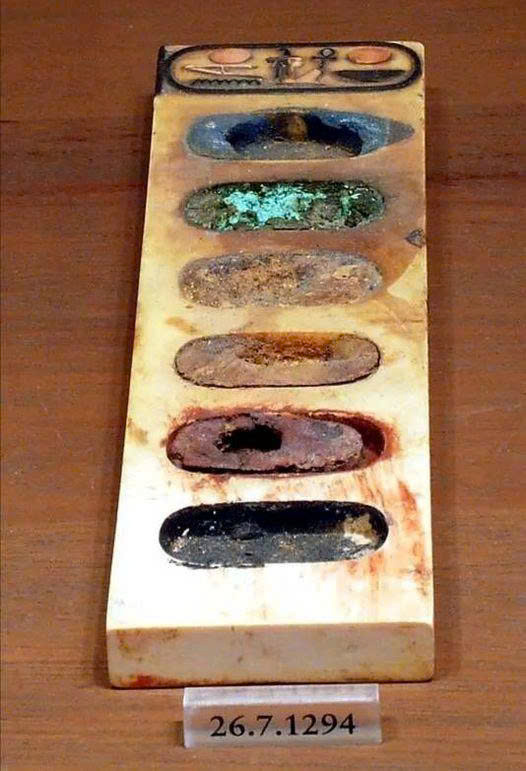In the vast tapestry of ancient Egyptian history, few artifacts tell such an intimate story of artistry and nobility as the 3,400-year-old paint box discovered from the New Kingdom period. This remarkable treasure, belonging to Vizier Amenemope during the reign of King Amenhotep II (around 1427-1401 BCE), stands as a testament to the sophisticated artistic practices of Egypt’s elite class.
The Paint Box: A Nobleman’s Artistic Companio
The wooden box, bearing the distinguished name of its owner, houses an extraordinary collection of pigments that have survived the millennia. Each color within tells its own story of innovation and craftsmanship. The rich red ochre speaks of earth and power, while the revolutionary Egyptian Blue – humanity’s first synthetic pigment – whispers tales of technological achievement. The carefully crafted green, born from a marriage of blue, yellow ochre, and orpiment, showcases the ancient Egyptians’ mastery of pigment manipulation. Two variations of carbon black complete this ancient palette, their deep tones once used to bring definition and life to countless works of art.
Art as a Symbol of Status and Spirituality
The Elite’s Creative Pursuit
As a Vizier, Amenemope stood at the pinnacle of Egyptian society. His paint box represents more than mere artistic tools – it symbolizes the privilege of leisure time and access to rare materials. Here was a man who could afford not only the precious pigments but also the luxury of pursuing art for pleasure, whether painting on papyrus or adding color to reliefs.
The Language of Colors

In the hands of ancient Egyptian artists, each pigment carried profound meaning. The red that flowed from their brushes represented vital energy and power. Blue and green spoke of rebirth and eternal life, while black – far from being a color of endings – symbolized fertility and new beginnings. These weren’t just colors; they were the vocabulary of a visual language that connected the earthly realm with the divine.
A Testament to Ancient Innovation

What makes this paint box truly remarkable is its role in showcasing ancient Egyptian technological prowess. The creation of Egyptian Blue, achieved by carefully heating a mixture of silica, copper compounds, lime, and alkali, demonstrates a sophisticated understanding of chemistry that was far ahead of its time. The preservation of these pigments over 3,400 years offers modern viewers a direct connection to this ancient mastery.
Legacy in Modern Times
Today, visitors to the Cleveland Museum of Art can stand before this extraordinary artifact and glimpse into a world where art, science, and spirituality intertwined. The paint box serves as a bridge across millennia, connecting us with an ancient Vizier who, despite the vast expanse of time, shared our human appreciation for creativity and beauty.

The story of Amenemope’s paint box reminds us that art has always been more than just decoration. In ancient Egypt, it was a mark of status, a form of spiritual expression, and a testament to human innovation. This 3,400-year-old collection of pigments continues to paint vivid pictures not just of colors, but of an entire civilization’s achievements and aspirations.

